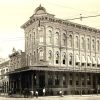calsfoundation@cals.org
William Henderson Cate (1839–1899)
William Henderson (W. H.) Cate was a lawyer, a judge, and a Democratic politician who served in the state legislature from 1871 to 1874 and in the U.S. House of Representatives from 1889 to 1890 and from 1891 to 1893. Charges of election fraud in the 1888 election resulted in federal hearings that saw him ousted from his congressional seat in 1890.
W. H. Cate, born on November 11, 1839, near Murfreesboro, Tennessee, was one of two surviving children born to Noah Cate, who was a Baptist minister, and his wife Margaret M. (Henderson) Cate. Raised in Tennessee’s Hawkins and Sullivan counties, he attended the common schools and academies in Abingdon, Virginia, and Rogersville, Tennessee. In 1857, he graduated from the University of Tennessee in Knoxville. By 1860, he was teaching school in Franklin County, Missouri, and studying law. Serving in the Confederate army during the Civil War, he attained the rank of captain. In 1865, he settled in Jonesboro (Craighead County), and he was admitted to the Arkansas bar in 1866. Beginning in 1867, he served as a lawyer for the Iron Mountain and Southern Railroad and, later, the St. Louis, Arkansas and Texas Railroad. In 1868, he married Virginia E. Warner of Craighead County; the couple had one son.
In the early 1870s, now established as a prominent Jonesboro attorney, Cate entered politics. As a Democrat in the state House of Representatives from 1871 to 1874, he served as a member of the Agriculture and the Cities and Corporations committees. Cate was elected prosecuting attorney for the second judicial circuit in 1878. Governor James H. Berry appointed him (and he was subsequently elected) as second judicial circuit judge in 1884. In 1882, he served as a member of the board of visitors of the University of Arkansas (UA) in Fayetteville (Washington County). In 1887, he helped to establish the Bank of Jonesboro, serving as its first president until July 1888. In 1891, he cofounded the Arkansas Bankers’ Association in Little Rock (Pulaski County).
In the 1888 election, the Democrats faced a serious challenge from an alliance between the Republicans and the Union Labor Party, which was an organization of Agricultural Wheel members and other groups. In 1888, Cate ran as the Democratic candidate for U.S. representative from the First Congressional District against Union Labor candidate Lewis P. Featherstone. Initially, Cate won the election with more than 15,000 votes overall to Featherstone’s 14,000-plus. In 1889, Cate took his seat in Congress, but Featherstone, aware of widespread election fraud, contested the election. Following the Featherstone v. Cate hearings held in the Republican-controlled U.S. House of the Representatives in 1889, Featherstone was seated in his place in 1890. Shortly after his unseating, Cate told the St. Louis Republic that “no one pretended to argue that the evidence Featherstone presented was sufficient. The Republican majority acted on evidence as to [election] irregularities [and] claimed [that] I should be unseated…to rebuke election methods in Arkansas generally.”
In the 1890 election, he again ran as the Democratic candidate for First Congressional District representative against Union Labor candidate Featherstone. Cate won the election with 15,437 votes to Featherstone’s 14,834. This time, Featherstone did not challenge the results. As a member of the Fifty-second Congress from 1891 to 1893, Cate served on the Railways and Canals Committee. In 1892, he introduced bills to establish a railroad bridge across the Black River and to improve navigation of the Mississippi River through construction of a levee on the St. Francis front. The St. Francis Levee District was established in 1893.
In 1892, Cate did not seek reelection to Congress. He resumed his law practice in Jonesboro. During a visit to Toledo, Ohio, he died of cancer on August 23, 1899. He is buried in the City Cemetery in Jonesboro.
For additional information:
“Arkansas Bankers’ Association Organized.” Arkansas Gazette, October 21, 1891, p. 1.
Arkansas General Assembly. Journal of the House of Representatives 1871. Little Rock: Gazette Printing Company, 1871.
Biennial Report of the Secretary of State of the State of Arkansas, October 1, 1882. Little Rock: Mitchell and Bettis State Printers, 1882.
Biennial Report of the Secretary of State of the State of Arkansas, September 30, 1892. Little Rock: Press Printing Company, 1893.
Biographical and Historical Memoirs of Northeast Arkansas. Chicago: Goodspeed Publishing Co., 1889.
“Cate Talks about His Case.” St. Louis Republic, March 11, 1890, p. 9.
Hempstead, Fay. A Pictorial History of Arkansas from Earliest Times to the Year 1890. St. Louis: N. D. Thompson Publishing Company, 1890.
“William Henderson Cate.” Biographical Directory of the United States Congress. http://bioguide.congress.gov/scripts/biodisplay.pl?index=C000249 (accessed January 30, 2024).
Melanie Welch
Mayflower, Arkansas
 Banking
Banking Post-Reconstruction through the Gilded Age, 1875 through 1900
Post-Reconstruction through the Gilded Age, 1875 through 1900




Comments
No comments on this entry yet.